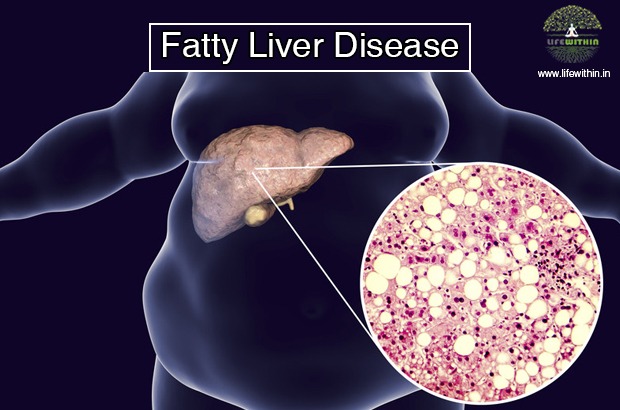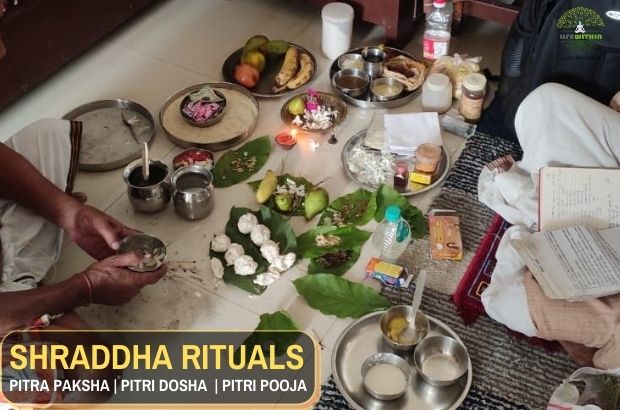How The Herb Protects The Liver From NAFLD And NASH | Dr. Vikram Chauhan
Non alcoholic fatty liver disease is more common in people with obesity and type two diabetes. The fatty liver disease i...
- by Life Within Editor
- May 14, 2021
- 962 views

How The Herb In The Liver From NAFLD And NASH
Abstract
Nonalcoholic fatty liver disease
(NAFLD) is an umbrella term which is used for a wide range of liver conditions
and hence affects people who do not drink alcohol. On the other hand NASH is
Non alcoholic steatohepatitis is a condition which is a form of non-alcoholic
fatty liver disease which causes liver cell damage, inflammation of liver and
also can result in liver fibrosis, scarring of liver or can lead to liver cirrhosis.
NASH can be considered as the next stage of non-alcoholic liver disease. NAFLD
is most common in people with obesity and type 2 diabetes. In this article we
will discuss both NASH and NAFLD along with a description of Yakrit Plihantak
Churna in protecting the liver from both of these conditions.
Introduction
Nonalcoholic fatty liver disease
is more common in people with obesity and type two diabetes. The fatty liver
disease is common in people with type two diabetes and prevalence ranges between
70%-80%. These patients are obese and have uncontrolled or flactuating sugar
levels. People with simple fatty liver condition do not develop complications
but when it is associated with Non-alcoholic steatohepatitis. NASH generally
leads toward liver cirrhosis and also liver cancer. Mostly, patients with NASH
die due to liver failure after landing in liver cirrhosis. The hepatic
lipotoxicity and non-liver factors, such as adipose tissue inflammation and
gastrointestinal imbalances were linked to evolution of Non-alcoholic fatty
liver disease. There are many reasons for the occurence of NAFLD but the
pathway of progression of this condition into NASH is still not known. Though
the pathogenesis of NAFLD and NASH appears to be multifactorial and many mechanisms
are being proposed as a possible cause for fatty liver infiltration.
Causes of Nonalcoholic fatty
liver disease
Most of the time the reason behind
nonalcoholic fatty liver disease is obesity associated with type two diabetes.
It's mostly the connection between disease and insulin resistance. Insulin is
basically a hormone and is responsible for glucose uptake by cells of various
muscles and tissue. Insulin also helps the liver in storing excess glucose.
When the body develops insulin
resistance that means it does not respond to insulin and the glucose build up
is commonly observed. As a result too much fat ends up accumulated in the
liver. This usually leads to inflammation and liver scarring.
Causes for NASH (Nonalcoholic
steatohepatitis)
As we have discussed earlier, this
condition is the advanced form of nonalcoholic fatty liver disease. When the
buildup of fat in the liver causes severe inflammation and damage then it is
called NASH.
Symptoms of both NAFLD and NASH
The symptoms generally include
pain in the upper right side of abdomen, fatigue, enlarged liver or spleen
(observed usually during examination by your physician), jaundice and yellowing
of skin and eyes.
- Symptoms you are landing in NASH
- Bleeding and bruising easily
- Itchy skin
- Yellow discoloration of skin and eyes
- Fluid buildup in abdomen
- Loss of appetite
- Swelling in legs
- Spider like veins on your skin
Risk factors for non-alcoholic
liver disease and NASH
- Diabetes
- High cholesterol levels
- Increased triglycerides
- Using corticosteroids
- Pregnancy
- Poor diet
- Metabolic syndrome
- Underactive thyroid (hypothyroidism)
Ayurvedic aspects of
non-alcoholic fatty liver disease and nonalcoholic steatohepatitis
In Ayurveda NAFLD and NASH is
understood as Yakrit Roga and the underlying cause of it is medoroga (obesity)
very often. Moreover Ayurveda explains some types of prameha (Diabetes
mellitus) as the result of obesity. Obesity is the result of kapha imbalance. A
person having more and more kapha vardhak aahar will face obesity and
deposition of fat in between the organs and in the liver is generally observed.
This aggravated kapha will stick over the cells as a layer and will destroy
their pillu agni which is called as the agni of each and every cell. Thus
decreasing the fat metabolism which is responsible for fat accumulation in the
liver and also aggravates extracellular pitta. All of this process will finally
result in fat deposition in the liver due to decreased fat metabolism and low lipotropic
activity. The fatty liver hence can be understood as a disease or disorder
taking place as a result of aggravated kapha which results in aggravation of
pitta as well and finally disturbes the fat utilization mechanism.
Yakrit Plihantak Churna for
protecting liver from NAFLD and NASH
Yakrit plihantak churna is a classical Ayurvedic formulation which has many beneficial herbs. These herbs are potent in enhancing liver functioning, removing accumulated fat in the liver and also are effective in showing liver protecting effects.
The
herbs which are the constituents of Yakrit Plihantak Churna are as follows:
- Bhumi Amla (Phyllanthus niruri)
- Katuki (Picrorhiza kurroa)
- Makoy (Solanum indicum)
- Punarnava (Boerhavia diffusa)
- Kalmegh (Andrographis paniculata)
- Kaasni (Cichorium intybus)
- Sharpunkha (Tephrosia purpurea)
- Bhringraj (Eclipta alba)
Bhumi Amla (Phyllanthus niruri)
Bhumi amla is having a
hepatoprotective effect and is also a really great antioxidant. Bhumi amla is
effective in balancing kapha and pitta in the body due to its bitter taste. It
has a very soothing effect on the liver and helps in improvement of pilu agni
at cellular level. Phyllanthus helps in removing excessive accumulation of fat
from the liver and also helps in good utilization of body fat.
Katuki (Picrorhiza kurroa)
Katuki roots contain picrorhiza
which is a bitter astringent and is best for liver detoxification. In addition
it regulates bile secretion and also removes excess of bile from the liver.
This herb helps in proper channeling of bile to the small intestine where it
helps in digestion of food. Katuki reduces the risk of landing in nonalcoholic
steatohepatitis and also of liver cirrhosis simultaneously.
Makoy (Solanum indicum)
The other name of makoy is
kaakmachi and it is an excellent liver strengthener. Makoy is having solanine, due to presence of
solanine this plant performs hepatoprotective as well as antidiabetic activity.
It reduces blood glucose level and also shows a brilliant effect on enhancing
pancreatic activity. It stimulates functioning of beta cells present in
pancreas which are responsible for insulin production.
Punarnava (Boerhavia diffusa)
Punarnava has two varieties,
shweta purna and rakta purna. The punarnava is very effective in protecting the
liver and also shows diuretic effect. Many classical samhita have mentioned
that punarnava reduces oedema over the liver and also shows mild protective
activity on pancreas too.
Kalmegh (Andrographis
paniculata)
Kalmegh is the king of bitters and
treats liver ailments really well. This herb helps in reducing swelling over
the liver, increases body’s immunity, soothes liver surface and pace up
functioning of liver cells which in turn do not allow accumulation of fat in
liver. Moreover it enhances pancreatic activity, helps in repairing beta cells
and regulates a good amount of insulin. The rise in insulin levels helps in
reduction of blood glucose and thus reduces fatty accumulations in the liver.
Kaasni (Cichorium intybus)
Kaasni is having a cholagogue
effect. This means it has properties that enhance the bile discharge from the
system and hence purgate it downward. It is very helpful in reducing
inflammation. Kaasni is a very well-known liver tonic which is also blended
into sherbet for ingestion. Kaasni is also helpful in improving liver and
pancreatic functioning and prevents fat accumulation in the liver.
Sharpunkha (Tephrosia purpurea)
Sharpunkha is having liver
protecting properties. This herb helps in reducing the effect of fat and
endotoxins on the liver. Due to its katu rasa it gives positive results in
detoxification of the liver and also regulates bile secretion. Sharpunkha is
beneficial in reducing accumulated fluid in the body due to its diuretic
property.
Bhringraj (Eclipta alba)
Bhringraj, like other herbs
mentioned above, has a liver protecting effect, manages good secretion of bile,
reduces accumulation of bile in the liver and also acts as a liver tonic.
Bhringraj supports liver functioning really well and is also very effective for
gallbladder stones if used along with ajwain.
Conclusion
Nonalcoholic fatty liver disease
(NAFLD) and Nonalcoholic steatohepatitis (NASH) are somewhat correlated.
Steatohepatitis can be considered as the next stage of NAFLD which at last
results in liver cirrhosis and hence patients either die or opt for liver
transplantation. But using Yakrit Plihantak Churna can change the scenario and
can really help in reducing fat accumulation and other symptoms related to this
liver ailment.
By: Dr. Vikram Chauhan
MD (Ayurveda) CEO & Founder of
Planet Ayurveda















